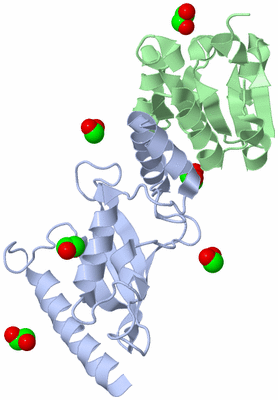| molecular function |
|---|
| | GO:0005524 | | ATP binding | | Interacting selectively and non-covalently with ATP, adenosine 5'-triphosphate, a universally important coenzyme and enzyme regulator. |
| | GO:0000166 | | nucleotide binding | | Interacting selectively and non-covalently with a nucleotide, any compound consisting of a nucleoside that is esterified with (ortho)phosphate or an oligophosphate at any hydroxyl group on the ribose or deoxyribose. |
| | GO:0005515 | | protein binding | | Interacting selectively and non-covalently with any protein or protein complex (a complex of two or more proteins that may include other nonprotein molecules). |
| | GO:0016740 | | transferase activity | | Catalysis of the transfer of a group, e.g. a methyl group, glycosyl group, acyl group, phosphorus-containing, or other groups, from one compound (generally regarded as the donor) to another compound (generally regarded as the acceptor). Transferase is the systematic name for any enzyme of EC class 2. |
| | GO:0061630 | | ubiquitin protein ligase activity | | Catalysis of the transfer of ubiquitin to a substrate protein via the reaction X-ubiquitin + S -> X + S-ubiquitin, where X is either an E2 or E3 enzyme, the X-ubiquitin linkage is a thioester bond, and the S-ubiquitin linkage is an amide bond: an isopeptide bond between the C-terminal glycine of ubiquitin and the epsilon-amino group of lysine residues in the substrate or, in the linear extension of ubiquitin chains, a peptide bond the between the C-terminal glycine and N-terminal methionine of ubiquitin residues. |
| | GO:0031625 | | ubiquitin protein ligase binding | | Interacting selectively and non-covalently with a ubiquitin protein ligase enzyme, any of the E3 proteins. |
| | GO:0004842 | | ubiquitin-protein transferase activity | | Catalysis of the transfer of ubiquitin from one protein to another via the reaction X-Ub + Y --> Y-Ub + X, where both X-Ub and Y-Ub are covalent linkages. |
| biological process |
|---|
| | GO:0007031 | | peroxisome organization | | A process that is carried out at the cellular level which results in the assembly, arrangement of constituent parts, or disassembly of a peroxisome. A peroxisome is a small, membrane-bounded organelle that uses dioxygen (O2) to oxidize organic molecules. |
| | GO:0051865 | | protein autoubiquitination | | The ubiquitination by a protein of one or more of its own amino acid residues, or residues on an identical protein. Ubiquitination occurs on the lysine residue by formation of an isopeptide crosslink. |
| | GO:0016562 | | protein import into peroxisome matrix, receptor recycling | | The process in which peroxisome targeting sequence receptors dissociates from cargo proteins and are returned to the cytosol. |
| | GO:0006513 | | protein monoubiquitination | | Addition of a single ubiquitin group to a protein. |
| | GO:0016567 | | protein ubiquitination | | The process in which one or more ubiquitin groups are added to a protein. |
| cellular component |
|---|
| | GO:0005777 | | peroxisome | | A small organelle enclosed by a single membrane, and found in most eukaryotic cells. Contains peroxidases and other enzymes involved in a variety of metabolic processes including free radical detoxification, lipid catabolism and biosynthesis, and hydrogen peroxide metabolism. |



 Description
Description
 Compounds
Compounds
 Chains, Units
Chains, Units
 Ligands, Modified Residues, Ions (1, 6)
Ligands, Modified Residues, Ions (1, 6)
 Sites (4, 4)
Sites (4, 4)
 SS Bonds (0, 0)
SS Bonds (0, 0)
 Cis Peptide Bonds (1, 1)
Cis Peptide Bonds (1, 1)
 SAPs(SNPs)/Variants (0, 0)
SAPs(SNPs)/Variants (0, 0)
 PROSITE Motifs (2, 2)
PROSITE Motifs (2, 2)
 Exons (0, 0)
Exons (0, 0)
 Sequences/Alignments
Sequences/Alignments
 SCOP Domains (0, 0)
SCOP Domains (0, 0)
 CATH Domains (0, 0)
CATH Domains (0, 0)
 Pfam Domains (0, 0)
Pfam Domains (0, 0)
 Gene Ontology (23, 27)
Gene Ontology (23, 27)
 Interactive Views
Interactive Views
 Still Images
Still Images
 Databases
Databases
 Analysis Tools
Analysis Tools
 Entries Sharing at Least One Protein Chain (UniProt ID)
Entries Sharing at Least One Protein Chain (UniProt ID)
 Related Entries Specified in the PDB File
Related Entries Specified in the PDB File

